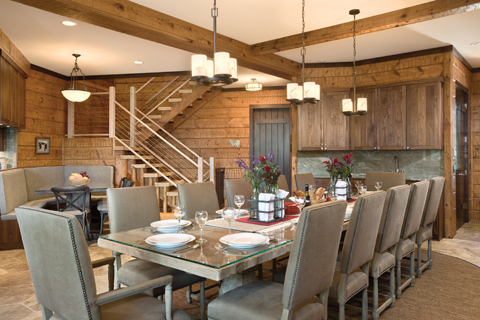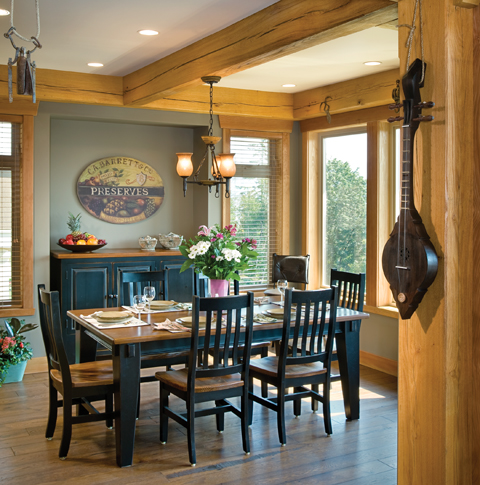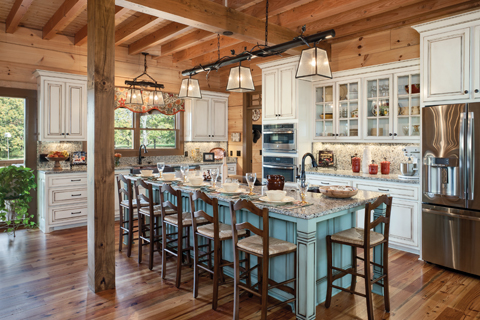A home is the epitome of self-expression. It shows the world your personal style and hints at what is important to you. It offers an escape from the world, creating a sanctuary for those who pass through its doors. But building the ideal sanctuary involves planning and budgeting to accommodate all the design options you might desire. Beginning with the structure, a home will speak volumes about who lives in it and where it is sited. But what about the design details that join your tastes with your budget? You may decide to upgrade the flooring to accommodate the long-term wear and tear small kids or dogs will have on them. Or you may decide to spend more on custom cabinetry, marble countertops, and upgraded appliances to fulfill a dream of cooking in a gourmet kitchen. So how do you find a compromise between where to skimp and where to splurge?
“Aside from having resources, whether the home is a ‘legacy property’ for future generations or strictly an investment plays a role in your decision to skimp or spend,” says Chris Wood, vice president of sales for Hearthstone Inc. in Newport, Tennessee. “You should consider spending on the rooms or areas you use the most and skimping on the areas used for occasional guests.”
“When we talk design, many of the questions we ask pertain to lifestyle,” says Cassandra Christianson, interior designer and project coordinator at Wisconsin Log Homes in Green Bay, Wisconsin. “For example, will you retire to this home? Do you have pets or kids? Will grandkids visit often? Will elderly parents live in or visit the home often? It’s also important to know if the home will be used year round or seasonally.”
The costs of building a home can add up through the design, build and finish stages. When reaching the design phase, you should take into account what makes you happy, what works with your lifestyle, and what your budget can accommodate.
“The type of activities you enjoy doing also have an effect on how to design certain rooms,” adds Christianson. “For instance, if your are on a lake, you may want an outdoor shower, or if you participate in snow activities, you will need a place to put boots, so maybe lockers and winter storage in a mudroom will be a necessity.”
What works for one family may not be ideal for another, so keep in mind that deciding where to skimp or splurge is very personal. We offer five prominent areas that can offer alternatives for skimping or splurging, depending on your individual tastes and budget.

Expedition Log Homes/photo by Roger Wade
1. Flooring
Flooring can be an attractive and eye-catching addition to any home, as it is the first thing you see when walking into a home. Homeowners face the decision of finding something that will stand up to wear and tear, but also suit the needs of the surrounding environment.
Flooring options have changed throughout the years, from the simplicity of carpet, wood and tile to newer, more diverse options such as bamboo, cork, stone, vinyl, and concrete. With different textiles being used, price tags can vary, offering homeowners numerous alternatives. Some options can create an illusion of a splurge when in fact they may have been a skimp, such as vinyl flooring that looks like wood or ceramic tile. It looks real, but without the real costs associated with such materials.
“Vinyl tiles with wood grain are interesting and acid-stained concrete slabs are ideal in the Deep South,” says Wood. “Mixing shells in with concrete and grinding or polishing in with a finished slab would be beautiful at the beach.”
“Flooring is always very open ended,” says Christianson. “Some clients select certain floors based on their lifestyle or what is most functional for the space, while others base it strictly on the look or their budget. It completely depends on the customers and what is important (or not) to them.”
Flooring options can add a steep price tag to the overall design budget. If you are looking to save some money and willing to think outside the box, you may find some new and exciting design potential that still keeps the budget on track.
2. Lighting
Lighting can transform a space by creating layers of warmth and setting the tone and mood for a room. It can make furniture, artwork, even people look amazing. But splurging on every light fixture and lamp will add a lot to the budget.
“With lighting you can go really simple and inexpensive or you can go more extravagant,” says Christianson. “The great room, kitchen, and dining room are all places to spend a little more on lighting since they are the main areas of the home and it can add some great design features. The laundry room or walk-in closets, for example, are locations where more cost-effective lights can be used since they are more utilitarian.”
Layering various styles, types, and wattages of lighting can also help with overall costs. “Decorative lighting can add a lot of character to a room, but make sure to layer different types of lighting to ensure you can utilize the space correctly,” says Christianson. “For example, in the kitchen, undercabinet lighting serves as task lighting for cooking and overhead can lights create an overall brighter space. Pair both of these with decorative pendants for a unique design feature, and your kitchen will have all the necessary light to create different settings.”
3. Cabinetry
Cabinetry, whether in a kitchen, bathroom, or specialty room, is an area you may assume is always a splurge category, but in reality it can be either a splurge or a skimp. The number of cabinets and their materials will greatly impact your costs.
When choosing materials, you might be deciding between stand-alone bureaus and built-in cabinetry, or considering custom solid wood versus manufactured veneer. Whatever the option, each comes with a respective price tag. And adding items such as roll-out shelving, special moldings or trims, glass inserts, or even extra tall cabinetry can add to the overall cabinetry budget.
Looking to skimp a bit but add the illusion of splurging? Consider having manufactured cabinets installed but hiring a custom craftsman to design custom made doors. Or forego the doors all together, creating exposed shelves, and add unique decorative features into the cabinetry, such as paint or wallpaper.

Riverbend Timber Framing/photo by Roger Wade
4. Countertops
Countertops in a kitchen or bathroom are another design option that can be changed to fit your design needs and your budget.
“Typically, clients will spend the money on granite or quartz countertops for their kitchen first,” says Christianson. “Since it gets so much use, you want to make sure it’s a durable product that will last a lifetime. Laminate is often used in laundry rooms or guest baths since it’s cost effective, yet there are some very nice patterns to choose from and it is also easy to clean.”
Economical options such as laminate that looks like granite or butcher block with an Old World feel can portray a sense of splurge without as much added cost. Dreaming of marble or granite countertops in the kitchen but your budget is not quite large enough? Consider using a more budget-friendly material for the main counter space and only upgrade the kitchen island countertop. For a smaller space, such as a bathroom vanity, consider purchasing a granite remnant, Christianson adds.
5. Appliances
When considering which appliances you want in your home, remember that some options are strictly aesthetic upgrades while others are functional. Forgoing aesthetic upgrades is a simple way to save on your budget unless you are trying to achieve a certain look. Functionality of appliances, however, may be a key determining factor in deciding where to splurge.
Will you be spending a lot of time cooking or entertaining in your home or will this be a vacation home you visit a couple times a year? Personal preference and usage demands play a large role in deciding where to spend or skimp. “Many appliances are made by the parent company and offered in a ‘good, better, best’ option. Quiet and efficient come at a cost,” Wood says.
These ideas are simply a starting point for many homeowners to explore different options. In the end, you may need to make some difficult decisions regarding where to skimp or where to splurge based on personal preferences. And if planned carefully, you will end up with the home of your dreams within your budget without a second thought as to where you skimped along the way.

